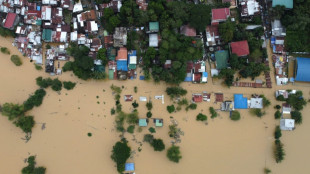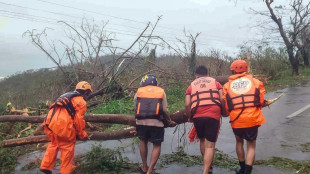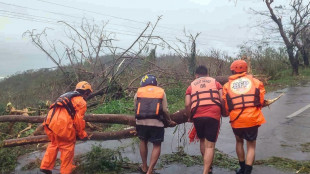
-
 Kane hoping to extend England career beyond 2026 World Cup
Kane hoping to extend England career beyond 2026 World Cup
-
Gazans rebuild homes from rubble in preparation for winter

-
 'Vague' net zero rules threaten climate targets, scientists warn
'Vague' net zero rules threaten climate targets, scientists warn
-
Stocks, dollar hesitant as traders eye US rate outlook, Nvidia

-
 G20 wrestles with wars, climate in run-up to Trump
G20 wrestles with wars, climate in run-up to Trump
-
'Agriculture is dying': French farmers protest EU-Mercosur deal

-
 Beyonce to headline halftime during NFL Christmas game
Beyonce to headline halftime during NFL Christmas game
-
Rescuers struggle to reach dozens missing after north Gaza strike

-
 Russia vetoes Sudan ceasefire resolution at UN
Russia vetoes Sudan ceasefire resolution at UN
-
G20 host Brazil launches alliance to end 'scourge' of hunger

-
 Stocks, dollar hesitant as traders scale back US rate cut bets
Stocks, dollar hesitant as traders scale back US rate cut bets
-
Trump confirms plan to use military for mass deportation

-
 Schools closed in Beirut after deadly Israeli air raid
Schools closed in Beirut after deadly Israeli air raid
-
Anger, pain in Turkey as 'newborn deaths gang' trial opens

-
 Kremlin says Biden 'fuelling' war as Russian strikes rock Odesa
Kremlin says Biden 'fuelling' war as Russian strikes rock Odesa
-
UN climate chief at deadlocked COP29: 'Cut the theatrics'

-
 G20 leaders gather to discuss wars, climate, Trump comeback
G20 leaders gather to discuss wars, climate, Trump comeback
-
Stocks, dollar mixed as traders scale back US rate cut bets

-
 Stoinis lets rip as Australia crush Pakistan for T20 series whitewash
Stoinis lets rip as Australia crush Pakistan for T20 series whitewash
-
Bentancur banned for seven games over alleged racial slur

-
 Kremlin says Biden 'fuelling' tensions with Kyiv missile decision
Kremlin says Biden 'fuelling' tensions with Kyiv missile decision
-
COP host Azerbaijan jailed activists over 'critical opinions': rights body

-
 Composer of Piaf's 'Non, je ne regrette rien' dies aged 95
Composer of Piaf's 'Non, je ne regrette rien' dies aged 95
-
South African trio nominated for World Rugby player of year

-
 'Not here for retiring': Nadal insists focus on Davis Cup
'Not here for retiring': Nadal insists focus on Davis Cup
-
Tractor-driving French farmers protest EU-Mercosur deal

-
 Floods hit northern Philippines after typhoon forces dam release
Floods hit northern Philippines after typhoon forces dam release
-
Pakistan skittled for 117 in final T20 against Australia

-
 Schools closed in Beirut after deadly Israeli strike
Schools closed in Beirut after deadly Israeli strike
-
Chris Wood hits hat-trick in NZ World Cup qualifying rout

-
 Markets mixed after Wall St losses as traders weigh US rates outlook
Markets mixed after Wall St losses as traders weigh US rates outlook
-
US, Philippines sign deal on sharing military information

-
 Bangladeshi ex-ministers face 'massacre' charges in court
Bangladeshi ex-ministers face 'massacre' charges in court
-
Law and disorder as Thai police station comes under monkey attack

-
 Disgraced Singapore oil tycoon sentenced to nearly 18 years for fraud
Disgraced Singapore oil tycoon sentenced to nearly 18 years for fraud
-
Philippines cleans up as typhoon death toll rises

-
 Quincy Jones awarded posthumous Oscar
Quincy Jones awarded posthumous Oscar
-
'Critically endangered' African penguins just want peace and food

-
 Long delayed Ukrainian survival video game sequel set for release amid war
Long delayed Ukrainian survival video game sequel set for release amid war
-
Star Australian broadcaster charged with sex offences

-
 Philippines cleans up after sixth major storm in weeks
Philippines cleans up after sixth major storm in weeks
-
Woman-owned cafe in Indonesia's Sharia stronghold shakes stigma

-
 Indigenous Australian lawmaker who heckled King Charles censured
Indigenous Australian lawmaker who heckled King Charles censured
-
End of an era as Nadal aims for winning Davis Cup farewell

-
 Trump taps big tech critic Carr to lead US communications agency
Trump taps big tech critic Carr to lead US communications agency
-
Mitchell-less Cavs rip Hornets as perfect NBA start hits 15-0

-
 Markets swing after Wall St losses as traders weigh US rates outlook
Markets swing after Wall St losses as traders weigh US rates outlook
-
India's capital shuts schools because of smog

-
 Rio under high security for G20 summit
Rio under high security for G20 summit
-
G20 leaders to grapple with climate, taxes, Trump comeback


Darwin's Galapagos island species, protected yet still at risk
Industrial fishing boats hover menacingly on the edges of Ecuador's Galapagos Marine Reserve, where schools of multicolored fish and hammerhead sharks frolic in the protected Pacific waters.
The reserve is a haven for the flurry of creatures and plants living in the waters around the Galapagos Islands where naturalist Charles Darwin found the inspiration for his theory of natural selection.
But outside its boundaries, not delineated by any physical barrier, there is no protection on the high seas where these same species also venture.
The sharks, turtles, iguanas, sea lions and fish that thrive in the Galapagos "don't understand political boundaries," Stuart Banks, a senior marine scientist at the Charles Darwin Foundation, told AFP on board Greenpeace's Arctic Sunrise research vessel.
"So they're going to be moving between different territories and that's when they're most at risk, particularly to things like industrial fishing and bycatch."
The solution, according to Greenpeace, is to secure a much larger area of ocean by creating the first-ever marine protected area on the high seas bordering the Galapagos Marine Reserve.
But for this to happen, at least 60 countries must ratify the High Seas Treaty adopted by United Nations member states last June. Only two have done so to date.
- Like a jigsaw puzzle -
AFP accompanied an Arctic Sunrise scientific mission to the area this month to investigate the threats posed to the Galapagos Marine Reserve, which Greenpeace describes as "probably the best conservation project carried out in the oceans."
The reserve of nearly 200,000 square kilometers (some 77,000 square miles) is one of the world's largest and most biodiverse with more than 3,000 species, many of them found nowhere else.
Biologist Paola Sangolqui explained she was testing water samples to analyze "which marine species have been in this area and have left some kind of DNA trace."
For his part, Daniel Armijos was in charge of underwater video monitoring of fish numbers and prevalence.
"It is kind of like putting together a big jigsaw puzzle because everything is integrated in some way," explained Banks.
"And if you're looking to prioritize the most important regions to start working, to know where those corridors are (along which species migrate), you need to use genetics so you can start to look at how particular populations are connected from one region to another."
- Hammerhead haven -
From the Arctic Sunrise, scientists also descended a robot to explore the coral reefs that serve as key feeding and breeding grounds for many fish, said expedition leader Sophie Cooke, for whom "the abundance of marine life in this national park is simply staggering."
Marine reserve employee Eduardo Espinoza, in charge of day-to-day monitoring, told AFP the archipelago is a rare sanctuary for hammerhead sharks, whose fins are a delicacy in some Asian countries.
Hammerheads were at particular risk of "overfishing and illegal fishing," Espinoza said as he fixed an identifying label to a young specimen.
"In the Galapagos, hammerhead sharks are always abundant. They have a refuge here to reproduce, from where they move throughout the Pacific," he added.
- Free species worth more -
Cooke said the Galapagos was an important migratory stop for many species, which is "why we need to connect all these different marine protected areas and protect these reserves: so the migration routes of these species can be kept safe."
The Galapagos Islands are designated a UNESCO Natural World Heritage site.
Another reason to protect the area is its attraction for tens of thousands of visitors every year, like American diver Ryan Doyle, 24.
"In comparison to Florida, where I'd also dive recreationally, there's so much life here," Doyle told AFP. "There's so many sharks and everything looks so healthy. So you can kind of like see the conservation" at work.
Diving instructor Anthony Gavilanes, 30, said locals like himself nowadays "live off tourism" more than fishing, as before.
"For us, species swimming freely in the water are worth more than they are on a plate served at a table."
E.Hall--AT




